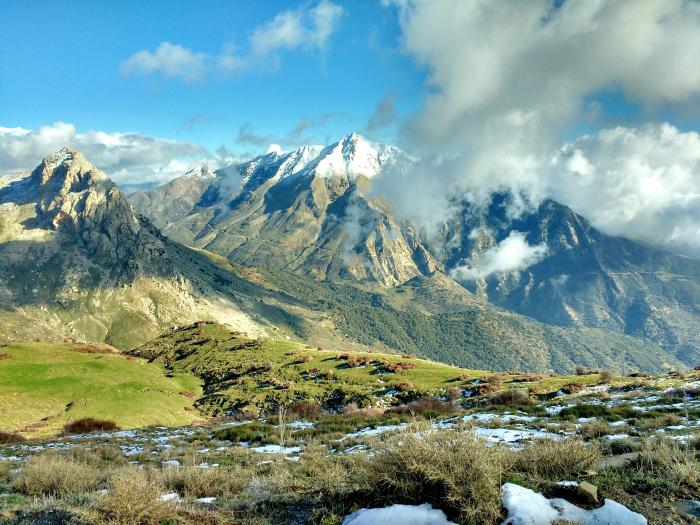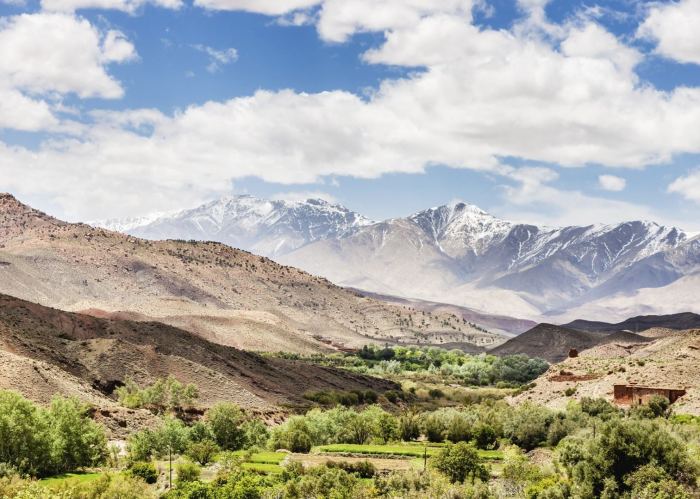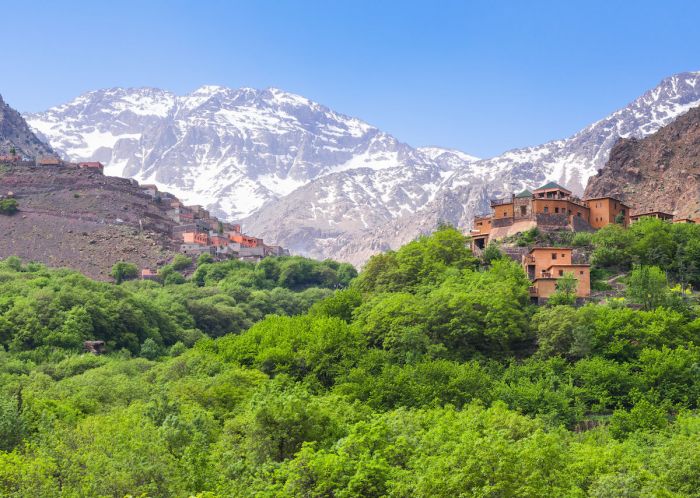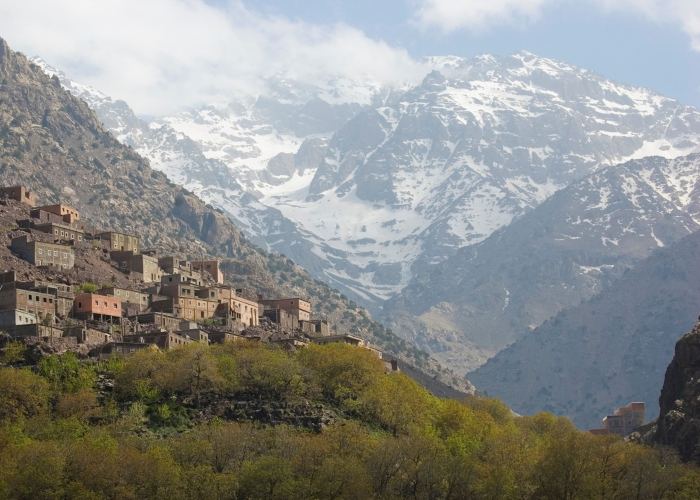Standing tall and proud, the Atlas Mountains have witnessed the ebb and flow of civilizations, sculpted landscapes with their geological wonders, and nurtured a rich tapestry of life. Embark on a captivating journey through these majestic peaks, where history, nature, and adventure intertwine.
From the towering summits of Mount Toubkal to the verdant valleys of the High Atlas, the Atlas Mountains offer a breathtaking panorama of natural beauty. Their geological origins, diverse ecosystems, and cultural heritage make them a treasure trove for explorers and nature enthusiasts alike.
Geological Formation and Composition

The Atlas Mountains, a majestic chain of peaks that spans across northern Africa, owe their existence to a complex interplay of tectonic forces that have shaped the region over millions of years. These mountains, composed of a diverse array of rock types and mineral deposits, bear witness to the dynamic geological processes that have sculpted the Earth’s surface.
Tectonic Processes
The formation of the Atlas Mountains can be traced back to the collision between the African and Eurasian tectonic plates, an event that occurred approximately 60 million years ago. As the African plate pushed northward, it collided with the Eurasian plate, causing the Earth’s crust to buckle and fold, giving rise to the Atlas Mountains. This collision zone, known as the Alpine-Himalayan orogenic belt, is responsible for the creation of some of the world’s most impressive mountain ranges.
Rock Types and Mineral Deposits
The Atlas Mountains are composed of a wide variety of rock types, reflecting the complex geological history of the region. Sedimentary rocks, such as limestone, sandstone, and shale, are abundant in the northern and central parts of the range. These rocks were formed from the accumulation of sediments over millions of years, primarily in marine environments. In contrast, the southern regions of the Atlas Mountains are characterized by igneous and metamorphic rocks, including granite, gneiss, and schist. These rocks were formed as a result of volcanic activity and the intense heat and pressure associated with the collision of the African and Eurasian plates.
The Atlas Mountains are also known for their mineral wealth. The range contains significant deposits of lead, zinc, copper, iron, and silver. These minerals have been mined for centuries and have played a vital role in the economic development of the region.
The Atlas Mountains, with their rugged peaks and breathtaking views, are a natural wonder of North Africa. While the Atlas Mountains offer a unique and unforgettable experience, travelers seeking a vibrant and cultural adventure can also explore the bustling city of Barranquilla in Colombia.
After immersing yourself in the rich history and traditions of Barranquilla, return to the Atlas Mountains for further exploration and discovery of its natural beauty.
Erosion and Weathering
The Atlas Mountains have been subjected to relentless erosion and weathering processes over time. Wind, rain, and temperature fluctuations have sculpted the mountains’ landscape, creating deep gorges, towering cliffs, and rugged peaks. The erosion of sedimentary rocks has exposed layers of fossils, providing valuable insights into the region’s ancient ecosystems. In addition, the weathering of igneous and metamorphic rocks has contributed to the formation of fertile soils, which support a diverse array of plant and animal life.
Geographical Features and Climate

The Atlas Mountains stretch across northwestern Africa, forming a rugged and diverse landscape. They encompass several major peaks, valleys, and plateaus, each with its own unique characteristics.
Peaks, Valleys, and Plateaus
The highest peak in the Atlas Mountains is Mount Toubkal, standing at 4,167 meters (13,665 feet) above sea level. Other notable peaks include Mount M’goun (4,071 meters), Mount Ayachi (3,757 meters), and Mount Saghro (2,712 meters). The mountains are also home to numerous valleys, including the Ourika Valley, the Assif Melloul Valley, and the Dadès Valley. These valleys provide fertile ground for agriculture and are often dotted with villages and towns. The Atlas Mountains also feature several plateaus, such as the High Atlas Plateau and the Middle Atlas Plateau. These plateaus are generally more arid than the valleys and are used for grazing livestock.
Climate
The climate of the Atlas Mountains varies considerably depending on altitude and latitude. In general, the mountains experience a Mediterranean climate, with hot, dry summers and mild, wet winters. However, at higher altitudes, the climate becomes more alpine, with cold winters and heavy snowfall. The northern slopes of the mountains receive more precipitation than the southern slopes, due to the influence of the prevailing westerly winds.
Influence of Altitude and Latitude
Altitude and latitude have a significant influence on the local climate of the Atlas Mountains. As altitude increases, temperatures decrease and precipitation increases. This is because the air at higher altitudes is thinner and less able to hold heat. Additionally, the higher elevations are more exposed to the cold, moist air masses that come from the Atlantic Ocean. Latitude also plays a role in the climate of the Atlas Mountains. The northern slopes of the mountains are closer to the Atlantic Ocean and therefore receive more precipitation than the southern slopes. The southern slopes are more influenced by the hot, dry air masses that come from the Sahara Desert.
Flora and Fauna

The Atlas Mountains are home to a diverse range of plant and animal life, reflecting the varied habitats found throughout the range. From the Mediterranean forests at the lower elevations to the alpine meadows near the summits, the Atlas Mountains support a wide array of species.
Plant Life
The plant life of the Atlas Mountains is primarily influenced by the Mediterranean climate, with evergreen forests and shrubs dominating the lower slopes. Common tree species include Aleppo pine, Atlas cedar, and cork oak. At higher elevations, the vegetation transitions to deciduous forests and alpine meadows, with species such as oak, beech, and juniper becoming more prevalent.
Animal Life
The Atlas Mountains are home to a variety of animal species, including many that are endemic to the region. Notable mammals include the Barbary macaque, a critically endangered primate found only in the Atlas Mountains of Algeria and Morocco. Other notable species include the Atlas mountain viper, a venomous snake found only in the Atlas Mountains, and the Barbary sheep, a large ungulate found in the high mountains of Morocco and Algeria.
The Atlas Mountains offer breathtaking landscapes and a rich cultural heritage. Planning a trip to this region requires careful consideration. To ensure a seamless experience, consider using a travel itinerary template. These templates provide a structured framework to plan your itinerary, optimize time, and maximize your exploration of the Atlas Mountains’ wonders.
Ecological Importance, Atlas mountains
The Atlas Mountains are considered a biodiversity hotspot, with a high concentration of endemic and endangered species. The mountains provide important habitat for a wide range of species, and play a crucial role in maintaining the ecological balance of the region.
Cultural and Historical Significance: Atlas Mountains

The Atlas Mountains have played a significant role in the history and culture of the region. The mountains have been inhabited by various civilizations throughout history, including the Berbers, Romans, and Arabs. The Berbers are the indigenous people of the Atlas Mountains and have a rich culture and history. They have lived in the mountains for centuries and have developed a unique way of life. The Romans conquered the Atlas Mountains in the 1st century BC and built many cities and roads in the region. The Arabs conquered the Atlas Mountains in the 7th century AD and introduced Islam to the region.
Today, the Atlas Mountains are home to a diverse population of people. The majority of the population is Berber, but there are also significant populations of Arabs, French, and other ethnic groups. The Atlas Mountains are a popular tourist destination and are known for their beautiful scenery, rich culture, and historical sites.
Berber Culture
The Berbers are the indigenous people of the Atlas Mountains. They have a rich culture and history that dates back centuries. The Berbers are known for their traditional music, dance, and art. They are also skilled craftsmen and women, and they produce a variety of beautiful textiles, pottery, and jewelry.
The Berbers have a strong sense of community and family. They live in small villages and towns, and they are very close to their neighbors. The Berbers are also very hospitable people, and they are always willing to welcome visitors into their homes.
Tourism and Recreation

The Atlas Mountains offer a wide range of opportunities for tourism and outdoor recreation. The region’s stunning scenery, rich cultural heritage, and diverse ecosystems attract visitors from around the world.
One of the most popular activities in the Atlas Mountains is hiking. There are numerous trails to choose from, ranging from easy day hikes to challenging multi-day treks. The trails wind through forests, across meadows, and up to mountain summits, offering breathtaking views of the surrounding landscape.
Ski Resorts
The Atlas Mountains are also home to several ski resorts, which offer skiing and snowboarding opportunities during the winter months. The resorts are located at high altitudes, ensuring reliable snow conditions. They offer a range of slopes for all levels of skiers and snowboarders, as well as amenities such as ski schools, rental shops, and restaurants.
The Atlas Mountains, a breathtaking natural wonder, offer a glimpse into the rich cultural heritage of North Africa. While exploring this awe-inspiring landscape, be sure to visit the Arts Centre Melbourne , a renowned performing arts venue showcasing world-class productions.
After immersing yourself in the vibrant arts scene, return to the Atlas Mountains, where you can marvel at their majestic peaks and immerse yourself in the local Berber culture.
Other Attractions
In addition to hiking and skiing, the Atlas Mountains offer a variety of other attractions, including:
- Rock climbing
- Mountain biking
- Horseback riding
- Cultural tours
- Wildlife viewing
The region is home to a number of national parks and protected areas, which offer opportunities to see a variety of wildlife, including Barbary macaques, wild boars, and eagles.
Economic and Social Benefits
Tourism is an important economic driver for the Atlas Mountains region. It creates jobs, generates revenue, and supports local businesses. Tourism also has a number of social benefits, such as promoting cultural exchange and fostering a sense of community pride.
Epilogue

As we bid farewell to the Atlas Mountains, their enduring legacy continues to inspire and captivate. They stand as a testament to the power of nature, the resilience of human spirit, and the boundless opportunities for adventure. Whether seeking solace in their serene landscapes or embracing the thrill of their rugged trails, the Atlas Mountains beckon us to explore, discover, and be forever enchanted.
Question Bank
What is the highest peak in the Atlas Mountains?
Mount Toubkal, standing at an elevation of 4,167 meters (13,665 feet).
What is the geological origin of the Atlas Mountains?
The Atlas Mountains were formed during the collision of the African and Eurasian tectonic plates, resulting in extensive folding and thrusting.
What is the climate like in the Atlas Mountains?
The climate varies greatly depending on altitude and location, ranging from Mediterranean to alpine conditions.
What are some popular tourist activities in the Atlas Mountains?
Hiking, trekking, skiing, mountain biking, and cultural exploration are among the popular tourist activities.